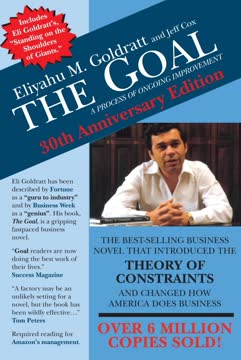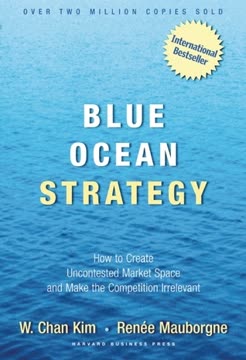Key Takeaways
1. The Technology Adoption Life Cycle: A roadmap for high-tech marketing
The Technology Adoption Life Cycle... describes how any community absorbs a discontinuous change.
The model's structure: The Technology Adoption Life Cycle is a bell curve divided into five segments:
- Innovators (Technology Enthusiasts)
- Early Adopters (Visionaries)
- Early Majority (Pragmatists)
- Late Majority (Conservatives)
- Laggards (Skeptics)
Key insights: Each group has distinct characteristics and motivations:
- Innovators: Pursue new technology aggressively
- Early Adopters: Seek competitive advantage through innovation
- Early Majority: Want proven productivity improvements
- Late Majority: Risk-averse, price-sensitive
- Laggards: Actively resist new technology
Understanding these segments is crucial for developing effective marketing strategies throughout a product's life cycle.
2. Crossing the Chasm: The critical transition to mainstream markets
The fundamental strategy for making a successful "crossing" is based on a single observation: the main difference between the visionaries of the early market and the pragmatists in the mainstream is that the former are willing to bet "on the come" whereas the latter want to see solutions "in production" before they buy.
The chasm challenge: The gap between early adopters and the early majority represents a significant hurdle for high-tech products. This transition is critical because:
- Early market success doesn't guarantee mainstream adoption
- Pragmatists require different marketing approaches than visionaries
- Failure to cross the chasm can lead to product failure
Crossing strategy: To successfully cross the chasm:
- Identify a specific target market segment
- Develop a complete "whole product" solution
- Position the product as the leader in that segment
- Create word-of-mouth momentum through reference customers
The key is to focus on a single, achievable beachhead market and dominate it before expanding.
3. The Bowling Alley: Niche-based adoption and market development
The bowling alley represents that part of the Technology Adoption Life Cycle in which a new product gains acceptance from niches within the mainstream market but has yet to achieve general, widespread adoption.
Bowling alley dynamics: This stage is characterized by:
- Niche market focus
- Customized solutions for specific segments
- Building momentum through sequential niche conquests
Strategic approach:
- Identify and prioritize niche markets
- Develop segment-specific whole products
- Leverage success in one niche to enter adjacent markets
- Focus on customer intimacy and application-specific expertise
The bowling alley strategy allows companies to build a strong foundation in the mainstream market while avoiding direct competition with established players.
4. Inside the Tornado: Hypergrowth and market dynamics
Tornadoes, when they occur, are destructive. They obliterate the old paradigm with swift ferocity. They catapult companies into market positions using forces that the companies themselves are barely aware of.
Tornado characteristics:
- Explosive market growth
- Mass-market adoption of a new technology paradigm
- Demand dramatically outstrips supply
- Rapid industry realignment and power shifts
Strategic imperatives:
- Maximize market share above all else
- Focus on operational excellence and high-volume production
- Standardize products and streamline distribution
- Attack competitors aggressively to gain dominant position
During the tornado, companies must shift from niche-focused strategies to mass-market approaches, prioritizing volume and speed over customization and customer intimacy.
5. Main Street: Sustaining growth and maximizing profitability
Main Street markets begin when the waves of frantic infrastructure replacement begin to subside, the new paradigm begins to settle in.
Main Street characteristics:
- Market saturation and slowing growth
- Commoditization of core products
- Increased focus on customer segmentation and value-added services
Strategic focus areas:
- Operational efficiency to compete on price in commodity markets
- Customer intimacy to develop value-added offerings
- Incremental product improvements ("+1" strategy)
- Exploring new market opportunities for future growth
On Main Street, companies must balance maintaining their core business with finding new sources of growth and differentiation.
6. Competitive Advantage: Strategies for each stage of the life cycle
The dominant theme is that the life cycle calls into play different value disciplines at different stages.
Value discipline focus by stage:
- Bowling Alley: Product leadership, customer intimacy
- Tornado: Product leadership, operational excellence
- Main Street: Operational excellence, customer intimacy
Strategic implications:
- Adapt competitive strategy to the current market stage
- Recognize the changing basis of competition as markets evolve
- Develop capabilities to excel in multiple value disciplines
- Anticipate and prepare for transitions between stages
Companies must be aware of their position in the life cycle and adjust their competitive strategies accordingly to maintain advantage.
7. Strategic Partnerships: Leveraging alliances for market success
Open systems business strategy puts a premium on partnerships to ensure rapid development of new technology markets.
Partnership dynamics:
- Evolve throughout the Technology Adoption Life Cycle
- Critical for developing complete "whole product" solutions
- Can shift from collaborative to competitive as markets mature
Key partnership strategies:
- Early market: Partner with system integrators and visionary customers
- Bowling Alley: Form alliances to create niche-specific solutions
- Tornado: Leverage partnerships for rapid scaling and distribution
- Main Street: Reevaluate partnerships based on value-add potential
Successful companies recognize the transient nature of partnerships and manage them strategically throughout the life cycle.
8. Positioning: Establishing your place in the market ecosystem
Positioning is one of the most misunderstood elements in business strategy, for all sorts of reasons, some profound, some superficial. The most profound, in my view, is that we continue to think our positioning is primarily a statement about us. It is not.
Positioning fundamentals:
- Defined by your role in the market ecosystem
- Influences how other market players interact with you
- Shapes customer perceptions and expectations
Key positioning strategies:
- Identify your quadrant: Old Guard, Explorer, Imperialist, or Barbarian
- Understand the power dynamics within your quadrant
- Communicate your role clearly and consistently
- Align your strategy and actions with your chosen position
Effective positioning helps companies navigate complex market relationships and establish a clear identity that resonates with customers and partners alike.
Last updated:
FAQ
What's Inside the Tornado about?
- Focus on Hypergrowth Markets: The book delves into strategies for thriving in hypergrowth markets, especially within the high-tech sector.
- Technology Adoption Life Cycle: It introduces the Technology Adoption Life Cycle, explaining how different customer segments adopt new technologies.
- Market Dynamics: Geoffrey A. Moore emphasizes understanding market dynamics during the shift from early adoption to mainstream acceptance.
Why should I read Inside the Tornado?
- Practical Strategies: Offers actionable strategies for navigating hypergrowth markets, crucial for entrepreneurs and executives.
- Real-World Examples: Includes case studies from companies like Oracle and Microsoft, illustrating successful market transitions.
- Framework for Success: Provides a framework for understanding market behavior and customer psychology to help businesses position themselves effectively.
What are the key takeaways of Inside the Tornado?
- Understanding Market Stages: Outlines six stages of the Technology Adoption Life Cycle, from Early Market to End of Life.
- Importance of the Tornado: Highlights the tornado phase as a critical period where demand outstrips supply, necessitating quick action.
- Adapting Strategies: Emphasizes the need for companies to adapt strategies based on market stages, focusing on customer needs and competition.
What is the Technology Adoption Life Cycle in Inside the Tornado?
- Stages of Adoption: Describes stages like innovators, early adopters, early majority, late majority, and laggards.
- Key Inflection Points: Identifies critical points like the chasm, where many products fail to gain mainstream success.
- Market Dynamics: Illustrates how market dynamics shift at each stage, requiring different strategies to align with customer expectations.
What is the Chasm, and why is it significant in Inside the Tornado?
- Transition Point: Represents the gap between early adopters and the mainstream market, where many companies struggle.
- Risk of Failure: Many innovative products fail to cross the Chasm, leading to lost investments and missed growth opportunities.
- Strategies for Crossing: Emphasizes the need for a whole product strategy to meet pragmatists' needs to successfully cross the Chasm.
What is the Bowling Alley concept in Inside the Tornado?
- Niche Market Focus: Refers to the stage where a product gains acceptance in niche markets before broader adoption.
- Leveraging Success: Companies should focus on winning niche markets to build momentum and establish market leadership.
- Building Momentum: This strategy helps companies prepare for the tornado phase by establishing a strong customer base.
How does the Tornado phase affect business strategy in Inside the Tornado?
- Mass Market Adoption: Characterized by rapid mass-market adoption, where demand significantly outstrips supply.
- Focus on Supply: Companies should prioritize shipping products quickly and efficiently, rather than customizing for individual needs.
- Competitive Dynamics: Creates a zero-sum game where winning customers means taking them from competitors, requiring aggressive strategies.
What are the implications of Main Street in the Technology Adoption Life Cycle?
- Post-Tornado Reality: Represents the phase after the tornado, where companies face increased competition in a stable market.
- Focus on Value: Companies need to shift focus from growth to maintaining customer satisfaction and profitability through value-based pricing.
- End User Engagement: Engaging end users becomes crucial, as they influence purchasing decisions and demand differentiated offerings.
What is the significance of the whole product concept in Inside the Tornado?
- Complete Solution: Refers to the complete set of products and services necessary for a customer to achieve their desired outcome.
- Meeting Pragmatist Needs: Ensures offerings meet pragmatists' needs, who require a fully functional solution to cross the Chasm.
- Competitive Advantage: A well-defined whole product can provide a competitive advantage by addressing customer pain points.
How does Inside the Tornado define the roles of gorillas, chimpanzees, and monkeys?
- Market Hierarchy: Gorillas are dominant market leaders, chimpanzees are strong competitors, and monkeys are opportunistic players.
- Power Dynamics: The tornado favors gorillas, allowing them to set standards and capture the majority of market share and profits.
- Strategic Positioning: Understanding these roles helps companies strategize their positioning and tactics during the tornado phase.
What is the role of +1 marketing in Inside the Tornado?
- Differentiation Strategy: Involves adding value to a core product with additional features or services to appeal to specific segments.
- Targeting Niche Markets: Aims to identify and target niche markets willing to pay a premium for added features, maintaining profit margins.
- Customer Experience Focus: Emphasizes creating a positive customer experience by addressing specific needs and preferences.
What are some common mistakes companies make during the Tornado phase in Inside the Tornado?
- Ignoring Customer Needs: Focusing too much on competition can lead to missed opportunities for customer loyalty.
- Overextending Resources: Expanding too quickly can result in operational failures and loss of market position.
- Failing to Adapt: Not adjusting strategies to the tornado's dynamics risks losing competitive edge and market share.
Review Summary
Inside the Tornado receives mixed reviews, with an average rating of 3.97/5. Readers appreciate its insights on tech market dynamics and business strategy, particularly the concept of the "whole product" for crossing the chasm. However, many find the book dated, with outdated examples and a focus on hardware rather than software. Some praise its enduring relevance and specific guidance, while others criticize its verbose writing style and lack of actionable advice. Despite its age, many readers still find value in its fundamental concepts for navigating technology market cycles.
Similar Books










Download PDF
Download EPUB
.epub digital book format is ideal for reading ebooks on phones, tablets, and e-readers.








